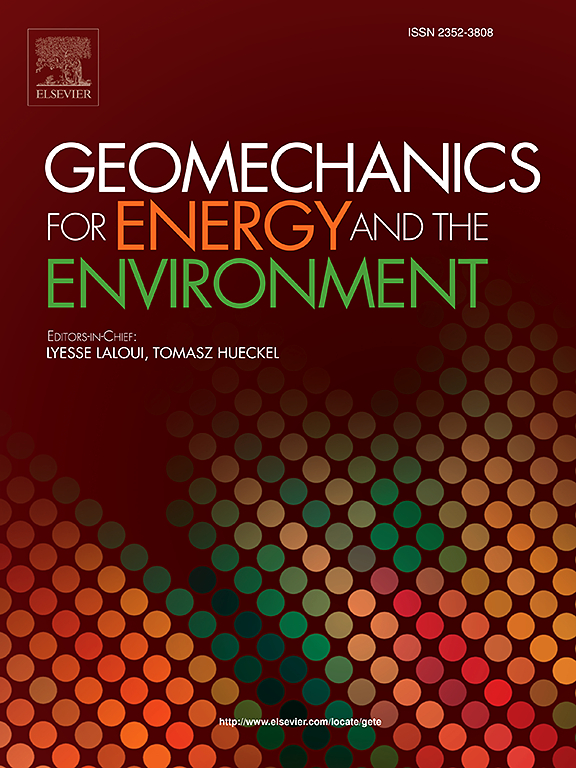Damage simulation of casing-cement interface of wellbore structure under non-uniform formation stress
IF 3.7
2区 工程技术
Q3 ENERGY & FUELS
引用次数: 0
Abstract
In ultra-deep drilling operations, formations such as creeping mudstone and high-pressure salt layers are frequently encountered, generating non-uniform loads that pose severe challenges to casing design and wellbore integrity. The interfacial bonding behavior between the cement sheath and casing is a critical factor governing the long-term integrity of the wellbore. This paper develops a damage model for the double-layer casing-cement sheath interface under non-uniform loading based on peridynamic theory. The model numerically characterizes the evolution mechanism of interface damage under non-uniform stress. Laboratory tests were conducted using a Digital Image Correlation (DIC) system to capture the strain evolution on the casing-cement sheath surface during radial compression. The results indicate that the peridynamic simulation of damage at the double-layer casing-cement sheath interface under non-uniform loading is in strong agreement with the DIC strain measurements. From the perspective of strain accumulation and damage morphology, increasing the outer casing radius enhances the overall structural stiffness. Strain accumulation at the inner casing-cement interface accelerates, with damage concentrated at the interface. while damage within the cement sheath primarily propagates along the 90° and 270° loading directions. In contrast, an increase radius of the inner casing reduces the constraint on the cement sheath, making the casing more prone to “ovalization” deformation. This extension of the stress transfer path slows strain accumulation at the inner casing–cement interface, with damage propagating along the 0°, 90°, 180°, and 270° directions. Experimental results further indicate that the load-bearing capacity of the model with an inner casing is at least 2.5 times higher than that of the model without an inner casing. The study reveals the mechanical mechanism governing the sealing capacity of the cement sheath in double-layer casings, providing significant theoretical and engineering implications for ensuring wellbore integrity and stability in oil and gas operations.
非均匀地层应力下井筒结构套管-水泥界面损伤模拟
在超深钻井作业中,经常会遇到蠕变泥岩和高压盐层等地层,这些地层会产生不均匀载荷,对套管设计和井筒完整性构成严重挑战。水泥环与套管之间的界面粘合行为是决定井筒长期完整性的关键因素。基于周动力理论,建立了非均匀载荷作用下双层套管-水泥环界面损伤模型。该模型对非均匀应力作用下界面损伤的演化机制进行了数值表征。使用数字图像相关(DIC)系统进行了实验室测试,以捕获径向压缩过程中套管-水泥环表面的应变演变。结果表明,非均匀载荷作用下双层套管-水泥环界面损伤的周动力模拟结果与DIC应变测量结果吻合较好。从应变积累和损伤形态的角度来看,增大外套管半径可以提高整体结构刚度。内套管-水泥界面应变积累加速,损伤集中在界面处。而水泥环内的损伤主要沿90°和270°加载方向传播。相反,内套管半径的增加减少了对水泥环的约束,使套管更容易发生“卵化”变形。这种应力传递路径的延伸减缓了内套管-水泥界面的应变积累,损伤沿0°、90°、180°和270°方向传播。实验结果进一步表明,加内壳模型的承载能力比不加内壳模型的承载能力至少提高2.5倍。该研究揭示了双层套管中控制水泥环密封能力的机械机制,为确保油气作业中的井筒完整性和稳定性提供了重要的理论和工程意义。
本文章由计算机程序翻译,如有差异,请以英文原文为准。
求助全文
约1分钟内获得全文
求助全文
来源期刊

Geomechanics for Energy and the Environment
Earth and Planetary Sciences-Geotechnical Engineering and Engineering Geology
CiteScore
5.90
自引率
11.80%
发文量
87
期刊介绍:
The aim of the Journal is to publish research results of the highest quality and of lasting importance on the subject of geomechanics, with the focus on applications to geological energy production and storage, and the interaction of soils and rocks with the natural and engineered environment. Special attention is given to concepts and developments of new energy geotechnologies that comprise intrinsic mechanisms protecting the environment against a potential engineering induced damage, hence warranting sustainable usage of energy resources.
The scope of the journal is broad, including fundamental concepts in geomechanics and mechanics of porous media, the experiments and analysis of novel phenomena and applications. Of special interest are issues resulting from coupling of particular physics, chemistry and biology of external forcings, as well as of pore fluid/gas and minerals to the solid mechanics of the medium skeleton and pore fluid mechanics. The multi-scale and inter-scale interactions between the phenomena and the behavior representations are also of particular interest. Contributions to general theoretical approach to these issues, but of potential reference to geomechanics in its context of energy and the environment are also most welcome.
 求助内容:
求助内容: 应助结果提醒方式:
应助结果提醒方式:


